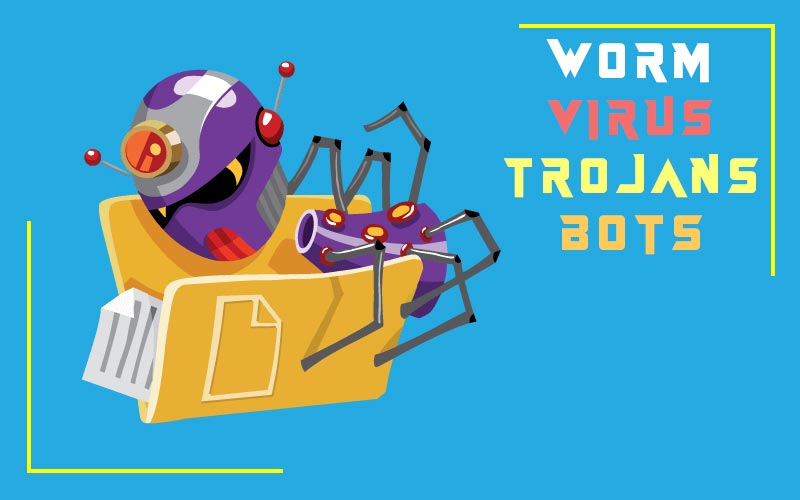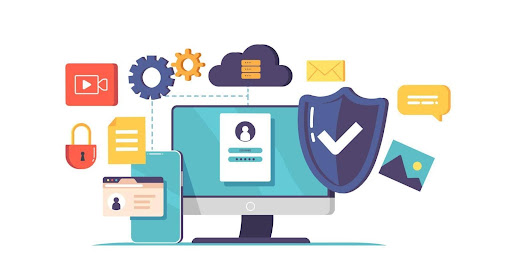Infections, worms, Trojans, and bots are all piece of a class of programming called “malware.” Malware is another way to say “malignant programming,” otherwise called noxious code or “malcode.” It is code or programming that is explicitly intended to harm, disturb, take, or when all is said in done exact some other “terrible” or ill-conceived activity on information, has, or arranges.
There is a wide range of classes of malware that have fluctuating methods for contaminating frameworks and engendering themselves. Malware can taint frameworks by being packaged with different projects or connected as macros to documents.
Others are introduced by abusing a known weakness in a working framework (OS), organize gadget, or another programming, for example, a gap in a program that just expects clients to visit a site to taint their PCs. A portion of the more ordinarily known sorts of malware are infections, worms, Trojans, bots, ransomware, indirect accesses, spyware, and adware.
Harm from malware differs from causing minor aggravation, (for example, program spring up advertisements) to taking secret data or cash, crushing information, and trading off as well as altogether handicapping frameworks and systems.
Table of Contents
Difference between a computer virus and worms
Classes of Malicious Software:
The two most common types of malware are viruses and worms. They have the property to self- replicate and can spread copies of themselves, which might be transformed copies. Malware has the ability to generate to be classified as a virus and works.
The main difference between worm and virus is that the worm operates more or less independently of other files, whereas a virus depends on a host program to spread itself. Below are some other classes of malicious software:
1. Ransomware:
It is a type of malicious software which intimidates to publish the victim’s data or continuously block access until payout is paid. Sometimes a simple payer may lock the system in a way that it is not difficult for an intelligent person to reverse, more advanced malware utilizes a method called cryptoviral extortion, which encrypts the file of a victim, making the files inaccessible and working a pay to decrypt them.
2. Viruses:
A virus found in a computer is a type of malware where a copy is inserted itself into which becomes a part of another program. It travels from one computer to another leaving infection. Viruses can range in severity from creating mildly annoying effects to damaging your data or software and causing denial-of-service (DoS) conditions.
An executable file is present in which almost all viruses are attached which means a virus might exist on a system but will not be active or able to spread until/unless a user runs/opens the malicious host file or program. However, when the viral code is executed, the host code is executed as well. Generally, the host program keeps functioning after it is infected by the virus.
The host program disrupts altogether when some viruses overwrite other programs with copies of themselves. The viruses begin to spread when the software/document (they are connected to) gets transferred from one to another using file sharing, a disk, infected email attachments or the network.
3. Worms:
Computers worms are alike to viruses as they replicate their operative copies and they can create the same type of damage. Worms are, however, independent software which does not require a host program or human help to propagate, in contrast to viruses which require the spreading of an infected host file. To spread, worms either exploit the vulnerability on the target system or use some kind of social engineering to trick users into executing them.
A worm access a personal computer via a vulnerability in the system and takes much advantage of file- transport or information transport features on the system which allows it to travel unaided. Many advanced worms leverage wipes, encryption, and ransomware methodologies in order to harm their targets.
4. Trojans:
A Trojan, named after the wooden horse that the Greeks used, is another type of malware. It is a harmful section of software that looks authorized. Loading and executing happen on the system through which users are typically tricked.
Once it is achieved any number of attacks on the host, from annoying the user (popping up windows or changing desktops) to almost damaging a host (stealing/deleting files or data, or activating/spreading other malware or viruses).
They are also known to create backdoors in order to give malicious users the system access. Unlike viruses and worms, Trojans don’t really reproduce by infecting other files or via self-replication. Trojans must spread via user interaction/contact, for example, opening an email attachment or downloading/running any file from the web.
5. Bots:
The word “Bot” is inspired by the word “robot” and is a default process that connects with the other network services. They operate tasks and provide information or services that would otherwise be conducted by a human. Its utilization is to collect the data/information like web crawlers, or automatically interact with IM (instant messaging), IRC or with the other interfaces on the web.
Bots are used for both the purpose of good and malicious intent. A malicious bot is a broadcast malware designed to interact with a host and connect again to the central servers that act as a command as well as a control center for a “botnet”. Moreover, with the help of Botnets, the attackers/invaders can launch broad-based or “remote- control” or even flood- type attacks against their target(s). Bots can mention an ability to log keystrokes, collect passwords, capture/analyze packets, in addition to the worm-like the ability of self-propagation.
Advantages of bots are similar to the advantages of worms, but are much versatile and smooth in their infection vector and are often modified within the hours of creation of a new exploit. They are known for their exploit backdoors unlocked by worms & viruses, allowing them to access networks with a good perimeter barrier. They hardly declare their appearance via high scans rates damaging the networking infrastructure, but they infect the networks in a manner that escapes instant attention.
Advanced botnets could definitely take advantages of the home electronics/devices in order to increase the attacks automatically. Moreover, these bots use Crypto mining for most of evil purposes.
Malware Distribution Channels:
Progressed malware normally comes by means of the accompanying circulation channels to a PC or system:
- Drive-by download— Unintended download of PC programming from the Internet
- Unsolicited email — Unwanted connections or implanted connections in electronic mail
- Physical media— Integrated or removable media, for example, USB drives
- Self-proliferation—Ability of malware to move from PC to PC or system to organize, in this manner spreading alone
Ten Best Practices for Combating Malware:
- Implementing first-line-of-safeguard devices that can scale, for example, cloud security stages
- Adhering to arrangements and practices for application, framework, and machine fixing
- Employing system division to help decrease episode exposures
- Adopting cutting edge endpoint process observing devices
- Accessing convenient, precise risk knowledge information and procedures that enable that information to be joined into security observing and eventing
- Performing more profound and further developed examination
- Reviewing and rehearsing security reaction systems
- Backing up information regularly and testing reclamation systems—forms that are basic in a universe of quick moving, arrange based ransomware worms and ruinous digital weapons
- Conducting security filtering of microservice, cloud administration, and application organization frameworks
- Reviewing security frameworks and investigating the utilization of SSL examination and, if conceivable, SSL decoding
Additional Terms:
Advanced Persistent Threats (API): A set of hidden and ongoing hacking processes, often arranged by a person or persons motive a specific entity. An APT usually targets and formats either private organizations, states, or both for business or political purposes. It requires a long period of time for a high degree of secretness. The word “advanced” signifies experienced techniques using malware to utilize vulnerabilities in systems.
The word “persistent” propose an external and deliberate command and control system is continuously monitoring and remove data from a specific target. The word “threat” indicates an arrangement of attack by human involvement.
1. Adware:
It is the software that generates revenue in the user interaction of the software or on a screen presented to the user during the installation process for its developer by automatically generating online advertisements. This software creates two types of revenue- a pay-per-click basis if the user clicks on the advertisement and the display of the advertisement.
2. Backdoor:
A migrant way of accessing and gaining a system, bypassing the normal verification mechanisms and techniques. Some backdoors are placed in the software by the original and authentic programmer and others are placed on the system through a system compromise and arrangement, such as a virus or worm. For easier and continued access to a system, attackers use backdoors after it has been compromised and settled.
3. Bootkit:
It is a malware variant that changes the boot sectors of a hard drive, including both MBR- Master Boot Record and VBR- Volume Boot Record. Opponents often use boot kits to persist at a system at a layer below the operating system, which can make it difficult sometimes to perform full remediation unless an organization conjecture one was used which might act accordingly.
4. Browser Hijacker:
A type of software which classifies web browser settings without the permission of a user to inject unwanted enacting into the user’s browser. It may replace or discard the existing home page, error page, or search engine with its processes.
They are usually used to force hits to a particular website, increasing its advertising revenue. This software usually comes in the form of a browser toolbar and is collected through an email attachment or a file download.
5. Crimeware:
This class of malware is designed specifically to automate cybercrime. Crimeware is designed to commit identity left through social engineering or technical privacy in order to access a computer user’s financial and retail accounts for the purpose taking funds from the accounts or completing unauthorized deals that develop the cyberthief. Unusually, crimeware steals confidential or sensitive corporate information.
6. Malicious crypto miners:
It is the software that uses systems resources to solve a long mathematical calculation which results in some amount of cryptocurrency being grant to the solvers. There are two ways by which mining can be performed- either with a single miner or by purchasing mining pools. Mining software trusts on both electricity and a CPU resource. Once a system has a minor decrease on it and it starts mining, nothing else is needed from an opponent perspective.
7. Malicious Mobile code:
Software having the malicious intent which gets transmitted from a remote host to the local host and then presented on the local host, typically without the user’s obvious instructions. The most used languages of the malicious Mobile code include Active X, Java, JavaScript, and VBScript.
8. Point of sale (POS) Malware:
It is the type of malicious software that is used by cybercriminals to target point of sale (POS) terminals with the intent to obtain or pursue credit cards and debit cards information by reading the device memory from the selling points of sale system. They are liberated why hackers to process and steal transition payment Data and information.
The card information is usually encrypted and delivered to the payment authorization, is not encrypted by POS Malware but sent to the cybercriminal.
What is a Computer Worm?
A Computer worm is a vindictive bit of programming that duplicates itself starting with one PC then onto the next with the objective of overwhelming the whole system of PCs. Most worms are intended to invade frameworks by abusing their security disappointments, while not many likewise attempt to change the framework settings.
In contrast to an infection, it is an independent program that doesn’t require a host. It generally doesn’t target records on an individual PC. Rather, it takes on whole systems trying to make huge botnets. When somebody makes reference to worms, you will likely think about the wriggly animals that youngsters play with and grown-ups use as a trap when angling.
Like them or not, worms are totally innocuous – except if you’re considering Computer worms. They may not be as damaging as PC infections, yet Computer worms can be similarly as risky.
Regardless of whether they don’t, they are still perilous as they take up a ton of data transfer capacity and other important assets. In spite of the way that numerous individuals utilize the two terms conversely, Computer worms are not equivalent to PC infections.
For one, PC diseases by definition target particular PCs, however, worm target frameworks of PCs to make botnets. Moreover, while infections are generally packaged with authentic records or projects, Computer worms are independent and don’t require a host document.
Various Types of Computer Worms:
In spite of the fact that there are no official measurements accessible, it is sheltered to state that there are well over a million Computer worms on the planet, each intended for a particular reason. Huge numbers of them have been disengaged and are currently routinely identified and expelled by the vast majority of the best antivirus programming. The five normal sorts are as per the following:
1. Web Worms
As they do with PC systems, Computer worms additionally target well-known sites with lacking security. When they figure out how to contaminate the webpage, webworms can recreate themselves onto any PC being utilized to get to the site being referred to.
From that point, webworms are dispersed to other associated PCs through the web and neighborhood associations.
2. Email Worms
Email worms are regularly dispersed by means of traded off email connections. They typically have twofold augmentations (for instance, .mp4.exe or .avi.exe) with the goal that the beneficiary would believe that they are media documents and not malevolent PC programs.
At the point when the unfortunate casualties click on the connection, duplicates of the equivalent tainted document will consequently be sent to addresses from their contacts list.
3. Texting Worms
Texting worms are actually equivalent to email worms, the main distinction being their strategy for conveyance. By and by, they are veiled as connections or interactive connect to sites. They are frequently joined by short messages like “LOL” or “You need to see this!” to fool the injured individual into imagining that their companion is sending them an amusing video to take a gander at.
At the point when the client taps on the connection or the connection – be it in Messenger, WhatsApp, Skype, or some other famous informing application – precisely the same message will at that point be sent to their contacts.
4. Record Sharing Worms
Albeit unlawful, record sharing and distributed document exchanges are as yet utilized by a great many individuals around the globe. Doing as such, they are unwittingly presenting their PCs to the risk of document sharing worms. Like email and texting worms, these projects are veiled as media documents with double expansions.
5. IRC Worms
Web Relay Chat (IRC) is an informing application that is generally obsolete these days yet was extremely popular when the new century rolled over. Same similarly as with the present texting stages, Computer worms were dispersed by means of messages containing connections and connections. The last was less powerful because of an additional layer of insurance that incited clients to acknowledge approaching documents before any exchange could occur.
The Computer Worm Examples
Jerusalem, the main realized Computer worms, was found in 1987. From that point forward, other Computer worms have made the news, either on account of their staggering impacts or because of the sheer size of the assault. The absolute most infamous computer worm examples incorporate the accompanying:
Morris Worm: It was propelled in 1988 by Robert Morris. To do this, he propelled a couple of dozen lines of code; however, he didn’t realize that the code was loaded with bugs that would cause an assortment of issues influenced to have. The outcome was a great many over-burden PCs running on UNIX and money-related harm extending between $10 million and $100 million.
Storm Worm: It is an email worm propelled in 2007. Unfortunate casualties would get messages with a phony news report about an exceptional tempest wave that had just murdered many individuals crosswise over Europe. More than 1.2 billion of these messages were sent throughout ten years so as to make a botnet that would target well-known sites.
Specialists trust that there are still, in any event, a million contaminated PCs whose proprietors don’t have the foggiest idea about that they are a piece of a botnet.
SQL Slammer: This was special in that it didn’t use any of the conventional dispersion strategies. Rather, it created various arbitrary IP locations and sent itself out to them with the expectation that they weren’t secured by antivirus programming. Moreover, in 2003, the outcome was in excess of 75,000 contaminated PCs unconsciously engaged with DDoS assaults on a few noteworthy sites.
How to Eject a Computer Worm?
On the off chance that you presume your PC may have been contaminated, it is imperative to run output and expel bargained records from your framework right away. Since worms misuse framework and programming vulnerabilities, you have to ensure that you’re continually utilizing the latest renditions of uses.
Turn on programmed updates of your working framework to guarantee that your PC is shielded from worms and other potential dangers. Try not to tap on any connections or open any connections except if you are certain beyond a shadow of a doubt they were sent by your companions and not a worm.
Screenshot Apps for Android:
Taking a screenshot, nowadays, has become a necessity. It doesn’t matter if it’s related to your work files that you sometimes open/use on your phone or pictures or anything. And most of the Android smartphones come with the two-button combo feature (lock/power button + volume down/home) to take screenshots. However, in order to edit/enhance the quality of the screenshot, one requires an app, especially if he wants to use it on the go. Here is a list of advanced Screenshot Apps for Android, check out now!





